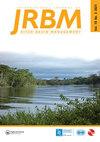Modelling of streamflow before and after dam construction in the Mono River Basin in Togo-Benin, West Africa
IF 1.9
Q3 WATER RESOURCES
International Journal of River Basin Management
Pub Date : 2021-08-22
DOI:10.1080/15715124.2021.1969943
引用次数: 4
Abstract
ABSTRACT The sub-tropical region of West Africa is not only vulnerable to the negative effects of climate change but also to the changes in land management. The goal of this study was to model streamflow in the Mono River Basin (MRB) for the period before (1964–1986) and after (1988–2011) dam construction. The Soil and Water Assessment Tool (SWAT) using input data such as a digital elevation model, soil and land use, and daily climate data model was set up, calibrated and validated for the period before dam construction (SIM1) and after dam construction (SIM2). The model sensitivity analysis, calibration and uncertainty analysis were performed based on daily observed streamflow using the Sequential Uncertainty Fitting procedure (SUFI-2) algorithm. The change in seasonal and annual streamflow between SIM1 and SIM2 was assessed and linked with land use/cover change between 1975 and 2000. The SWAT model shows satisfactory performance with Kling-Gupta Efficiency (KGE) ≥ 0.60 and percent bias |PBIAS| ≤ ±20 during calibration and KGE ≥ 0.50 and |PBIAS| ≤ ±15 during validation of SIM1 and SIM2. The results further showed that the construction of the dam affected the hydrological system of the catchment with a change in annual average streamflow between SIM1 and SIM2 of −14.13%, −19.86% and 3.66% at Athiéme, Tététou and Corrokope stations, respectively. The simulated average streamflow amplitude of SIM2 has decreased globally compared to SIM1. Therefore, the changes detected in land use/cover may have affected the average streamflow in response to the difference in amplitude simulated streamflow of SIM1 and SIM2. The finding of this analysis demonstrated that the impacts of dam construction on streamflow are challenging and crucial for water resource management in MRB.西非多哥-贝宁莫诺河流域大坝建设前后的水流模拟
摘要西非亚热带地区不仅容易受到气候变化的负面影响,而且容易受到土地管理变化的影响。本研究的目标是对莫诺河流域(MRB)大坝施工前(1964–1986)和施工后(1988–2011)的流量进行建模。土壤和水评估工具(SWAT)使用输入数据,如数字高程模型、土壤和土地利用以及每日气候数据模型,在大坝施工前(SIM1)和大坝施工后(SIM2)建立、校准和验证。模型灵敏度分析、校准和不确定度分析基于每日观测流量,使用顺序不确定度拟合程序(SUFI-2)算法进行。对SIM1和SIM2之间的季节性和年度流量变化进行了评估,并将其与1975年至2000年间的土地利用/覆盖变化联系起来。SWAT模型在Kling Gupta效率(KGE)下表现出令人满意的性能 ≥ 0.60和偏差百分比|PBIAS| ≤ 校准期间±20和KGE ≥ 0.50和|PBIAS| ≤ SIM1和SIM2验证期间的±15。结果进一步表明,大坝的建设影响了流域的水文系统,在Athiéme、TéTétou和Corrokope站,SIM1和SIM2之间的年平均流量变化分别为−14.13%、−19.86%和3.66%。与SIM1相比,SIM2的模拟平均流量振幅在整体上有所下降。因此,检测到的土地利用/覆盖变化可能影响了SIM1和SIM2模拟流量振幅差异的平均流量。该分析结果表明,大坝建设对径流的影响对MRB的水资源管理具有挑战性和关键性。
本文章由计算机程序翻译,如有差异,请以英文原文为准。
求助全文
约1分钟内获得全文
求助全文
来源期刊

International Journal of River Basin Management
WATER RESOURCES-
CiteScore
6.00
自引率
4.00%
发文量
48
期刊介绍:
include, but are not limited to new developments or applications in the following areas: AREAS OF INTEREST - integrated water resources management - watershed land use planning and management - spatial planning and management of floodplains - flood forecasting and flood risk management - drought forecasting and drought management - floodplain, river and estuarine restoration - climate change impact prediction and planning of remedial measures - management of mountain rivers - water quality management including non point source pollution - operation strategies for engineered river systems - maintenance strategies for river systems and for structures - project-affected-people and stakeholder participation - conservation of natural and cultural heritage
 求助内容:
求助内容: 应助结果提醒方式:
应助结果提醒方式:


